
- Operation: Addition
- Height: 5’4”
- Weight: 143 lbs
- Zodiac: Pisces
- Favorite food: Calzones
- Quote: “Follow your heart!”
The Evil Evens have taken to the skies in an attempt at deck domination! The only things stopping them are four intrepid Ace Pilots and your ace arithmetic skills.
Ace Pilot is a cooperative card game for one to four
players1 that uses a standard deck of cards.
Pilots flip through the deck until they reveal an even card, then
attempt to defeat it using the arithmetic abilities of the pilots in
play. This continues until either all pilots have been defeated or the
deck has been expunged of those Evil Evens.
Each session is designed to be brief but challenging. Though some situations may seem impossible at first glance, most are winnable. And you’ll feel oh-so-clever when you solve them.
Ace pilot is, at its heart, miniature math puzzles. You’ll flip over cards to reveal a target number, carefully choose which cards to keep, then construct an equation using those cards to match that target value.
The challenge comes from this core mechanic: you may only play cards to one Ace at a time, and the arithmetic performed will be based on that Ace.
Just remember the following mnemonics and you’ll be fine:
This only applies to the Aces. Suit doesn’t matter for the rest of the cards.
Get to know your pilots! You can skip this section if you’re a math maniac, but the game is more fun with a flair for the dramatic, and these pilots are itching to take to the skies.
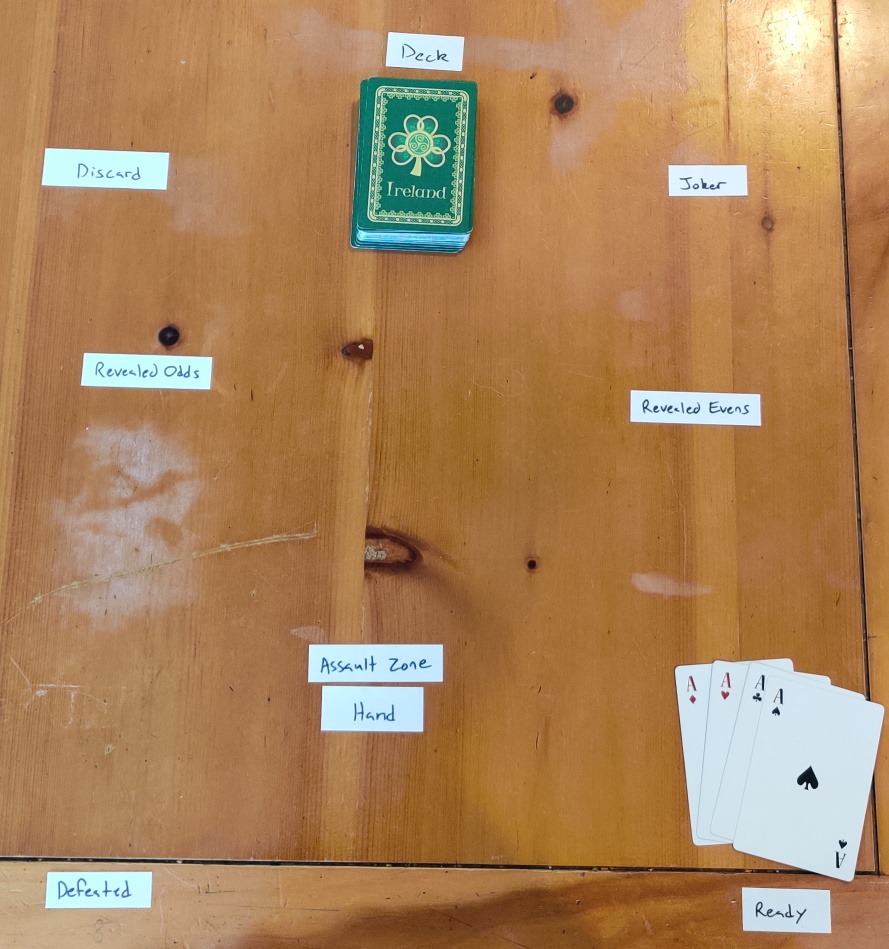
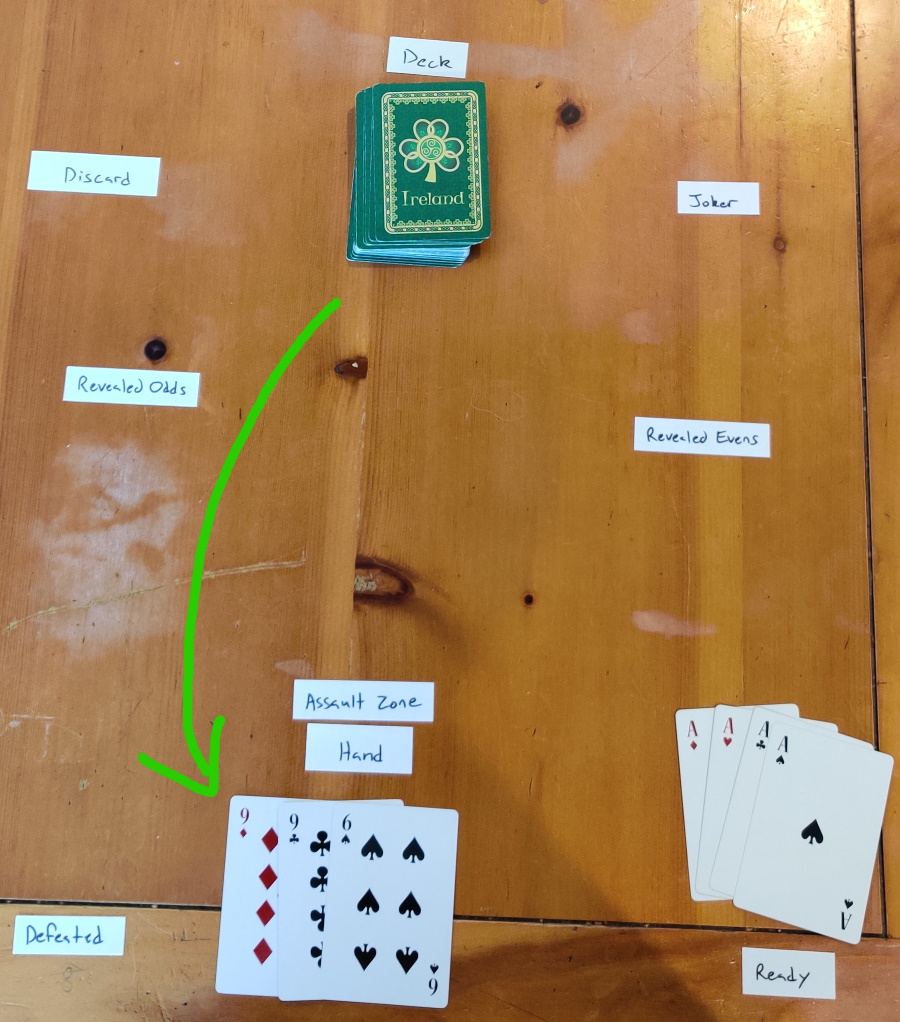
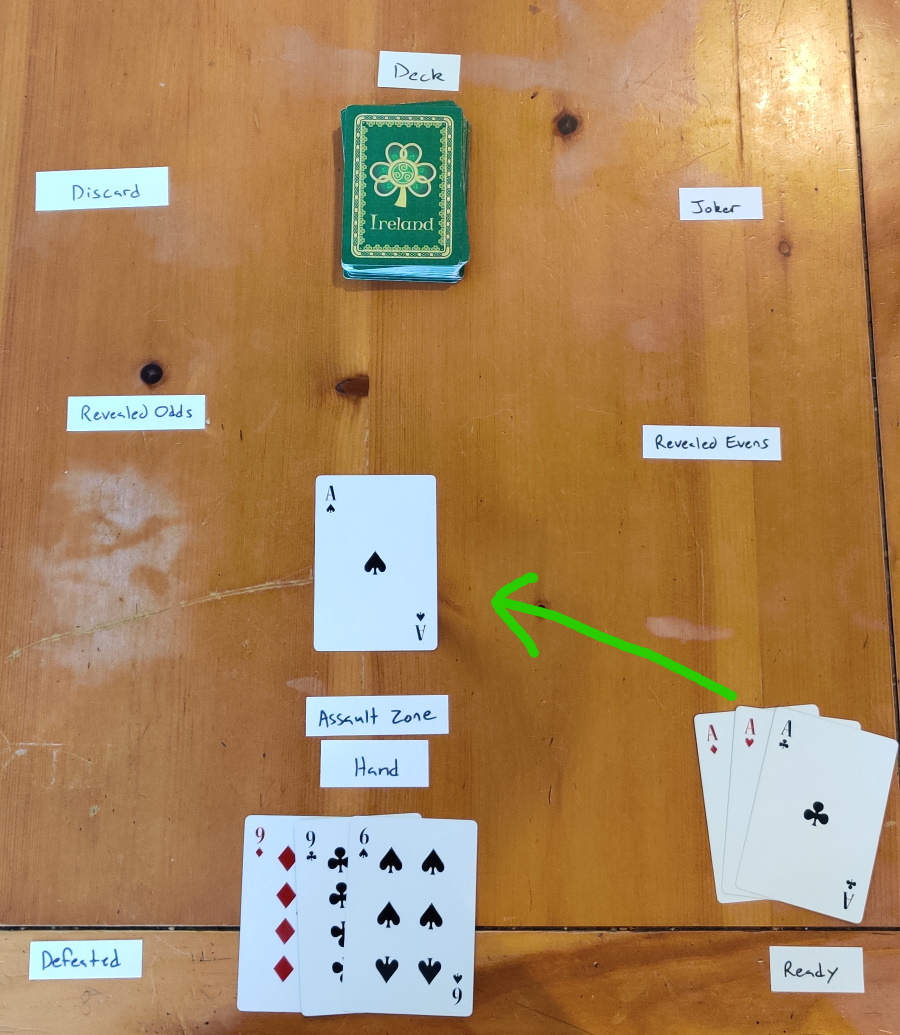
Initial setup
-> 3 cards drawn -> Pilot picked.

Recommended card zone arrangement.
A video which demonstrates a live session and incidentally explains most of the rules as they come into play is available here. It’s often easier to make sense of in action.
The below sections will also have annotated images from a different playthrough.
Reveal cards from the top of the Deck one by one.
Note that jacks are worth 11 (odd), queens are worth 12 (even), and kings are worth 13 (odd).
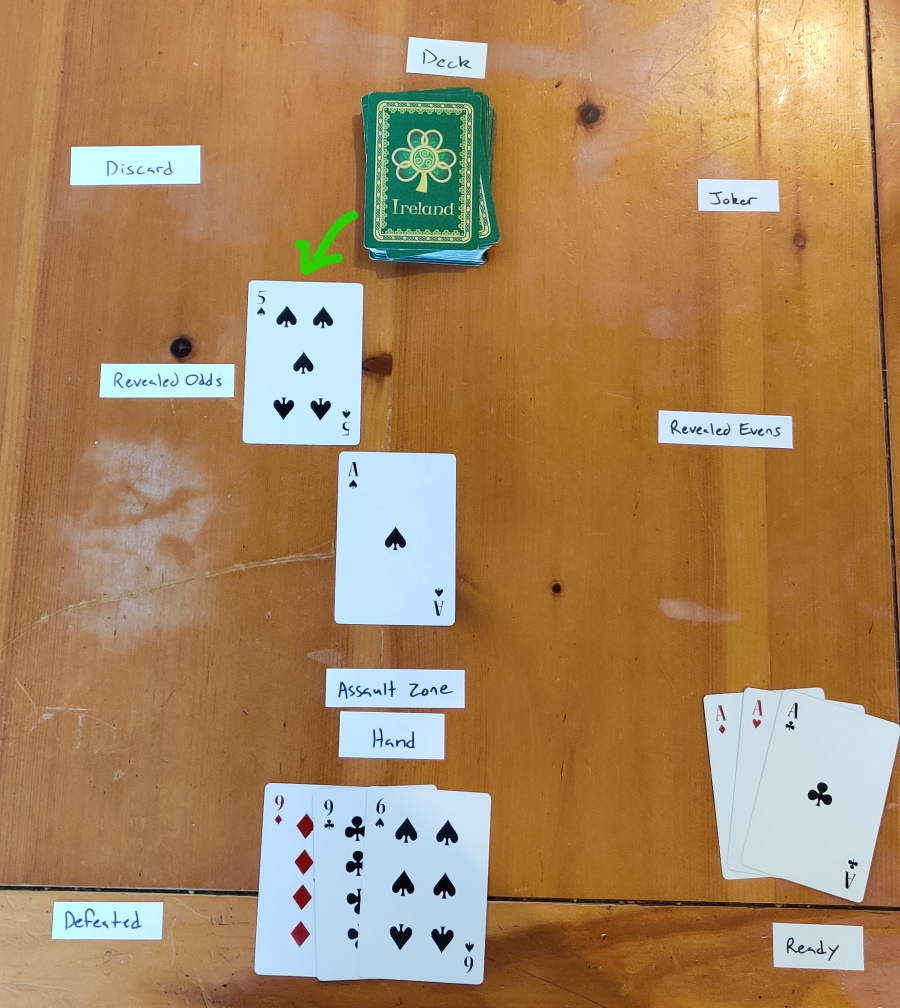
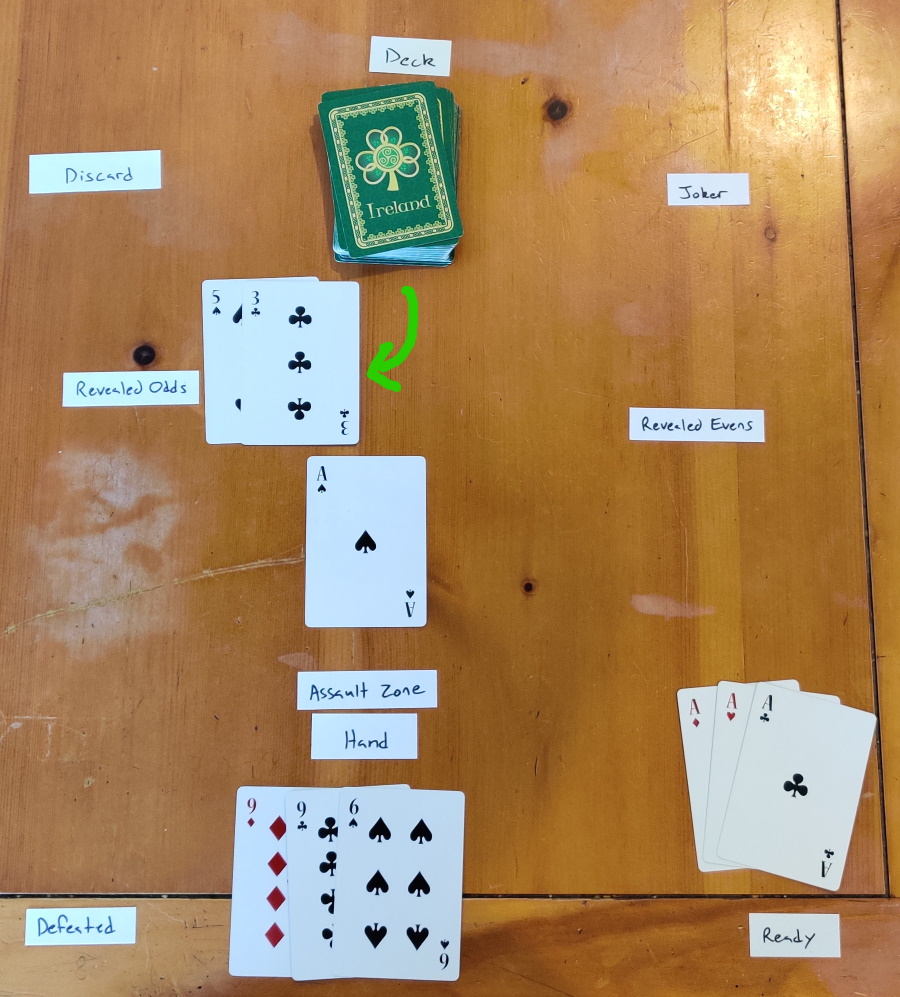
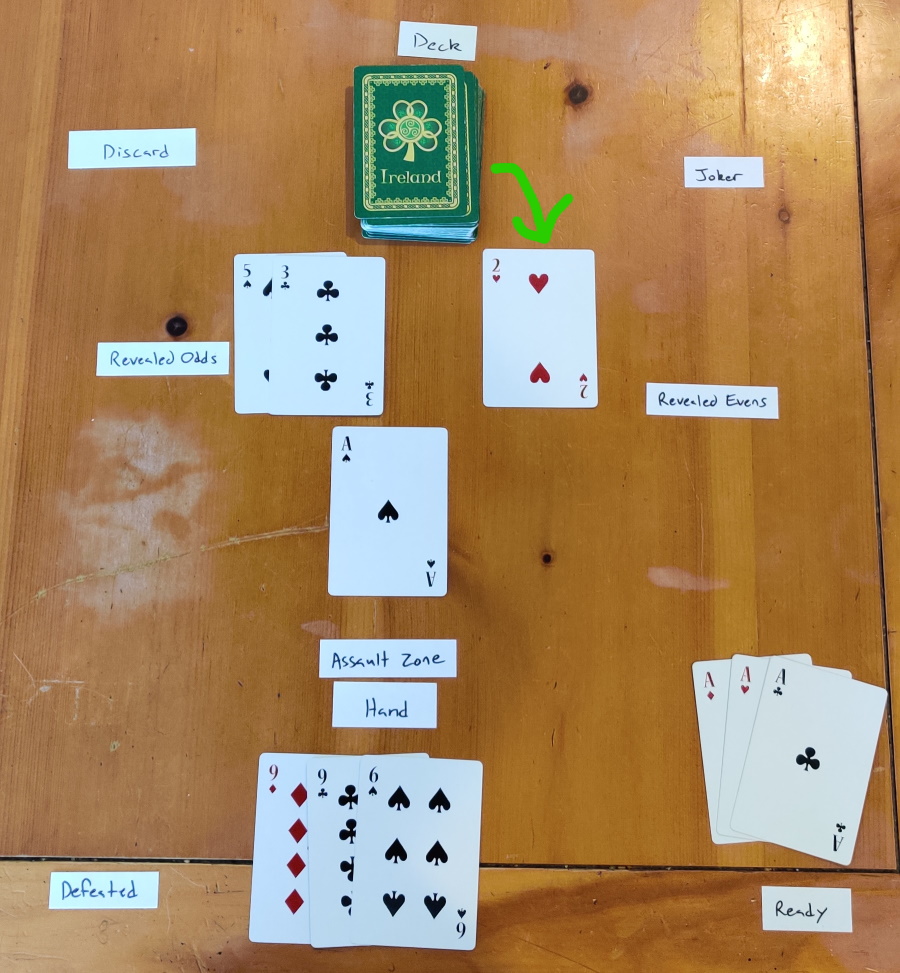
Reveal Odd -> Reveal Odd -> Reveal Even.
Take a 4th card into your hand.
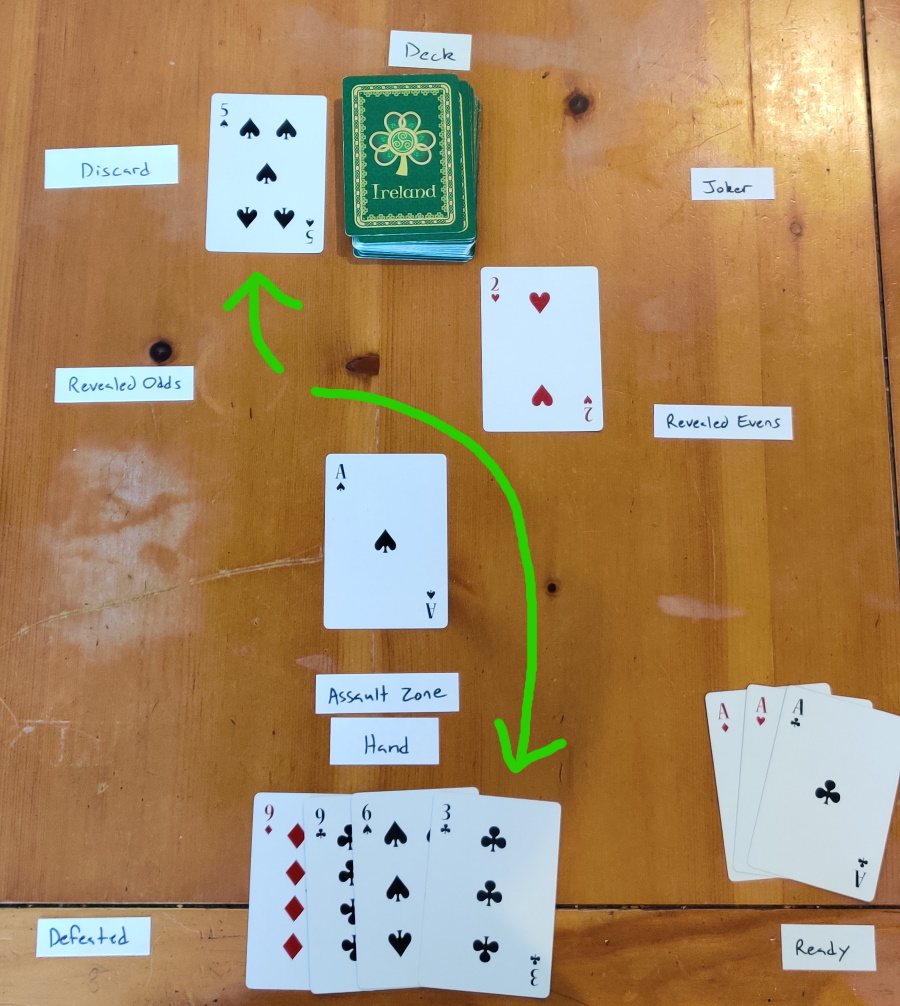
We
drew the 3 and discarded the 5.
Each Ace Pilot can only perform one arithmetical operation: Hearts heighten (+), Spades subtract (-), Clubs combine (x), and Diamonds divide (/).
The trick of the game is to find the right order to arrange your Aces such that the cards played on them resolve to your target value.
You should have exactly one Ace in the Assault Zone: it was either the last pilot played during the previous equation, the one you picked before drawing a 4th card if you were defeated last round, or the one you picked before revealing the first cards at the beginning of the game.
That Ace is considered your Starting Pilot for this round.
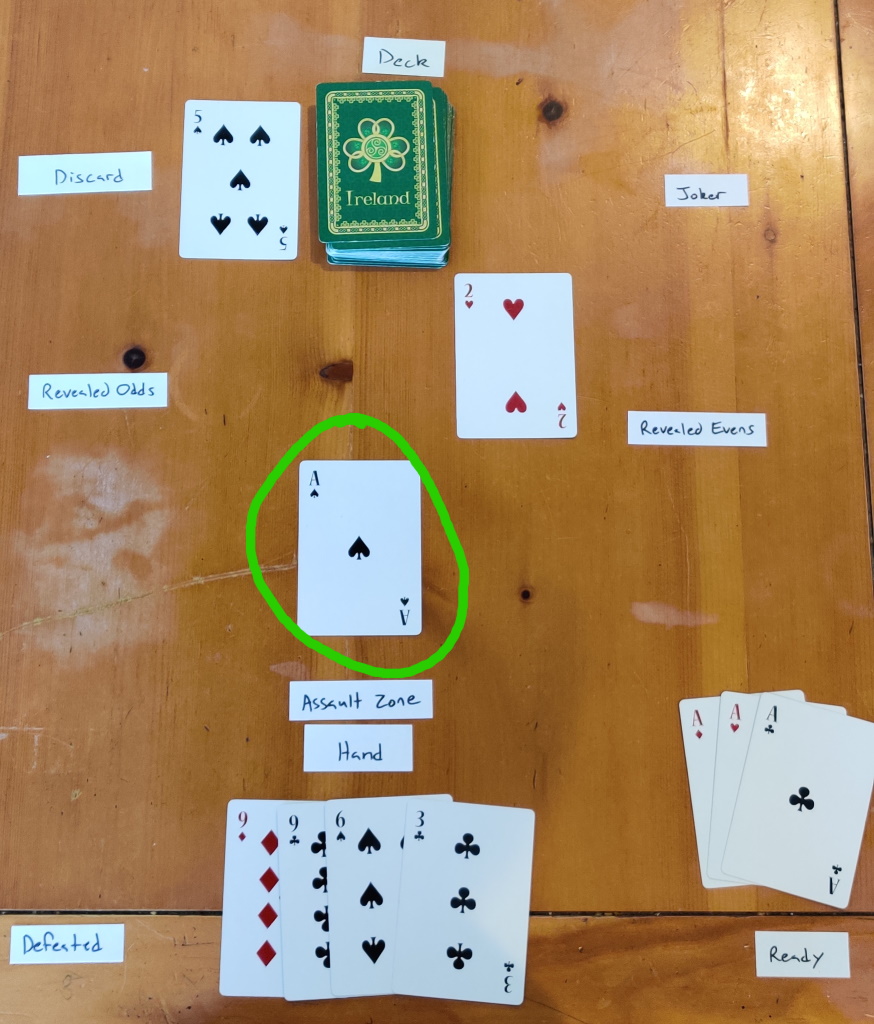
Starting Pilot.
The Starting Pilot must have two or more cards played on it before any additional Aces can be added to the equation.
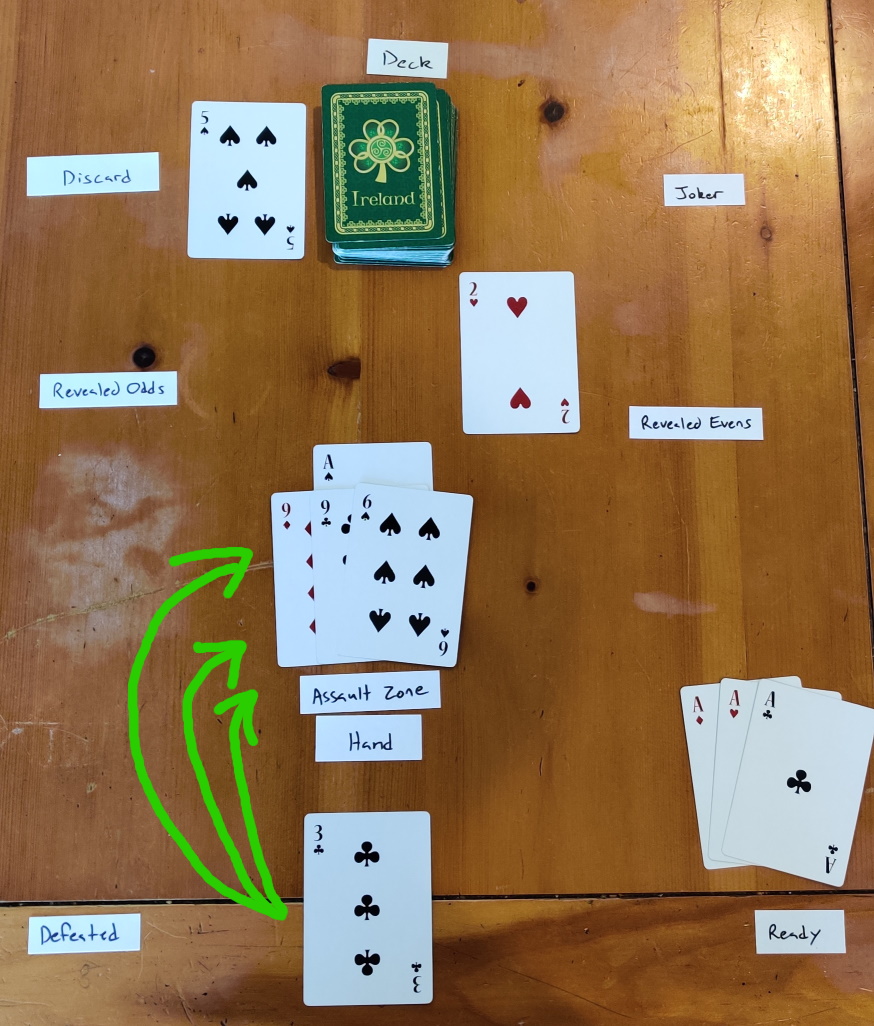
We chose to play 3 cards here, which satisfies the minimum of 2.
Once two or more cards have been played on your Starting Pilot, you may choose to add another Ace to the equation if necessary.
Whichever Ace you play last, regardless of where it is in the equation, is your Ending Pilot. Keep that in mind for later.
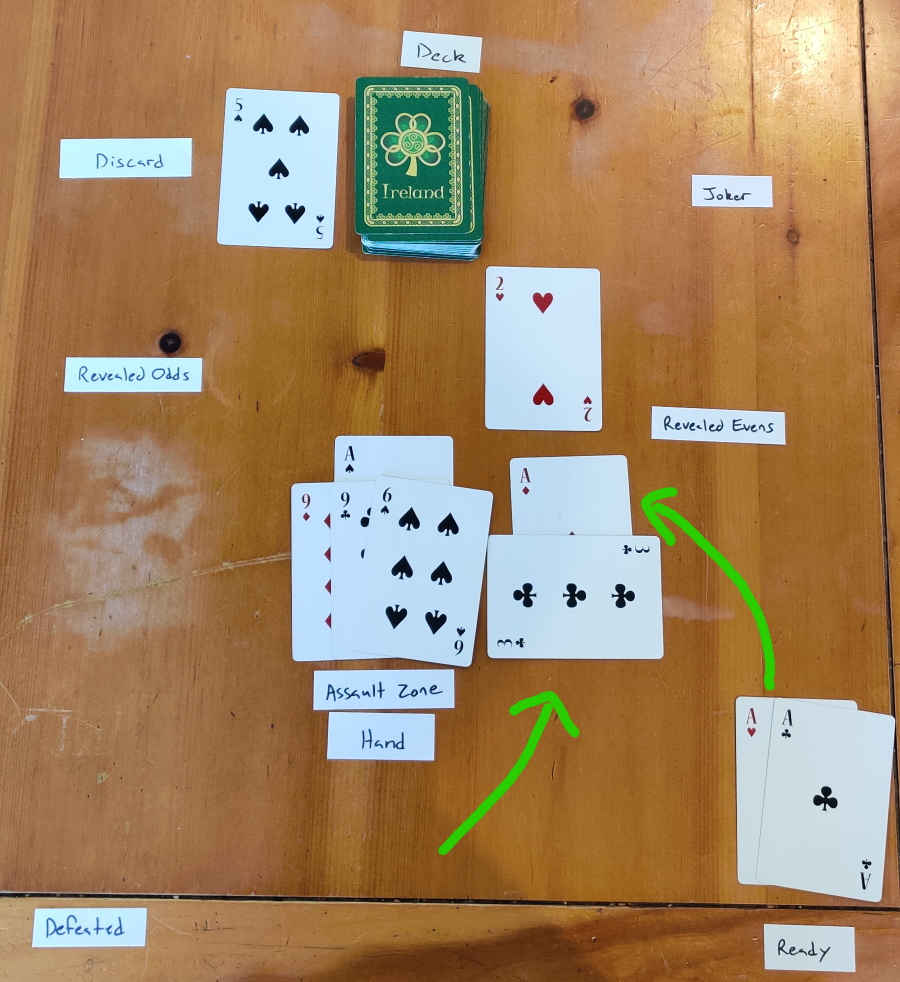
We
chose to play Duke (Diamonds /) and a 3. He becomes our Ending Pilot.
We play the 3 sideways to indicate that it’s a Carryover Card.
If an Ace has two or more cards played to it (such as your Starting Pilot), resolve its value according to basic arithmetic:
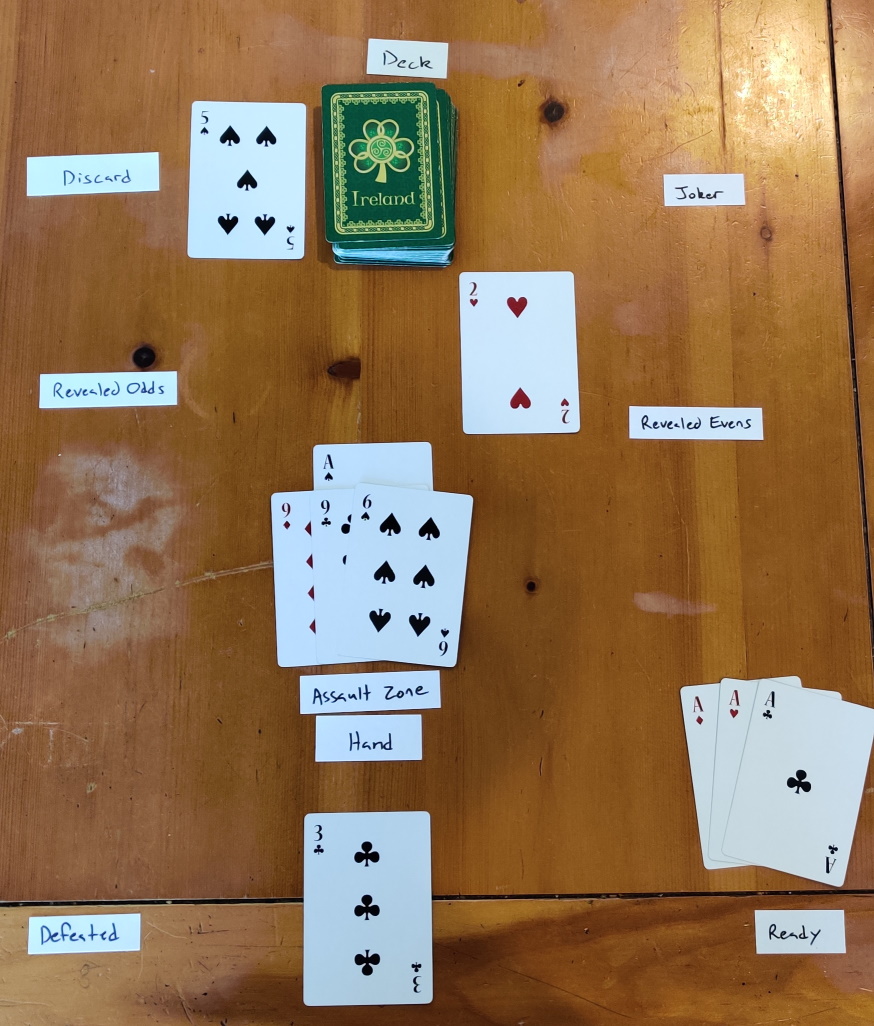
9
- 9 - 6 = -6. Which becomes 6.
When multiple Aces exist in the Assault Zone they are resolved from left-to-right according to the following rules:
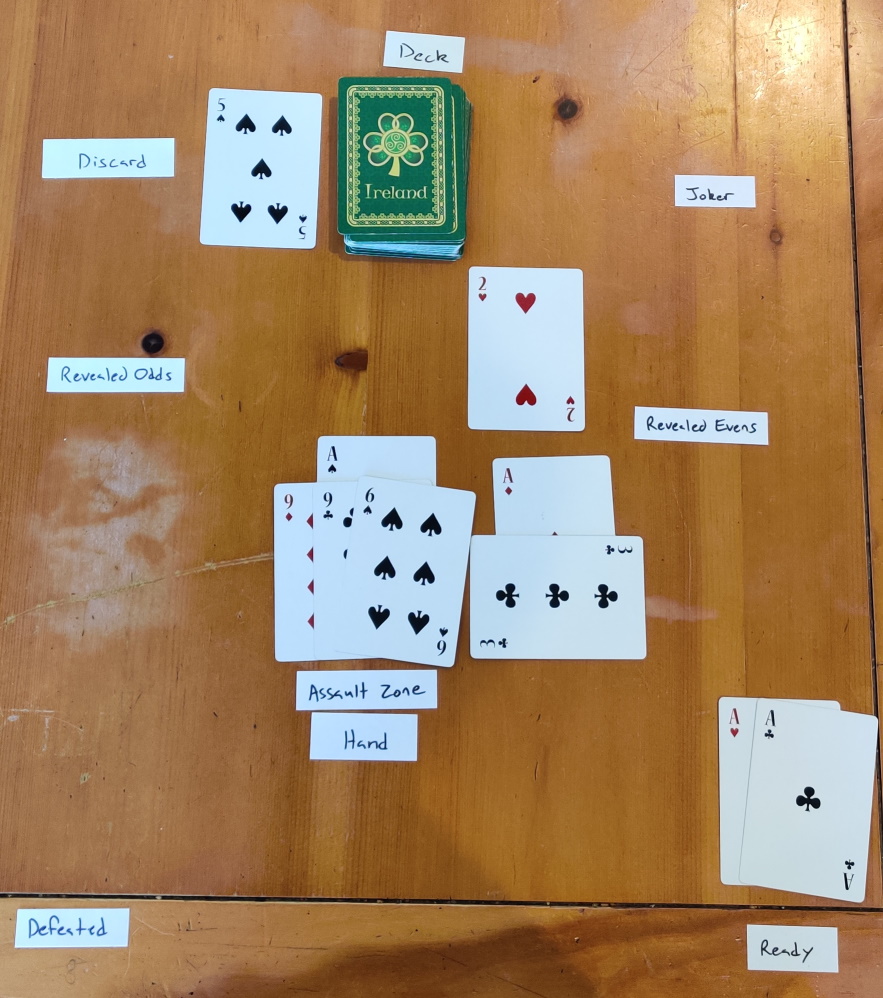
Sabina: 9 - 9 - 6 = -6 = 6. Duke: 6 / 3 = 3!
Take all of the cards used in the Assault Equation into your hand. This includes the Evil Even you just defeated – the power of arithmetic has convinced them to join your side!
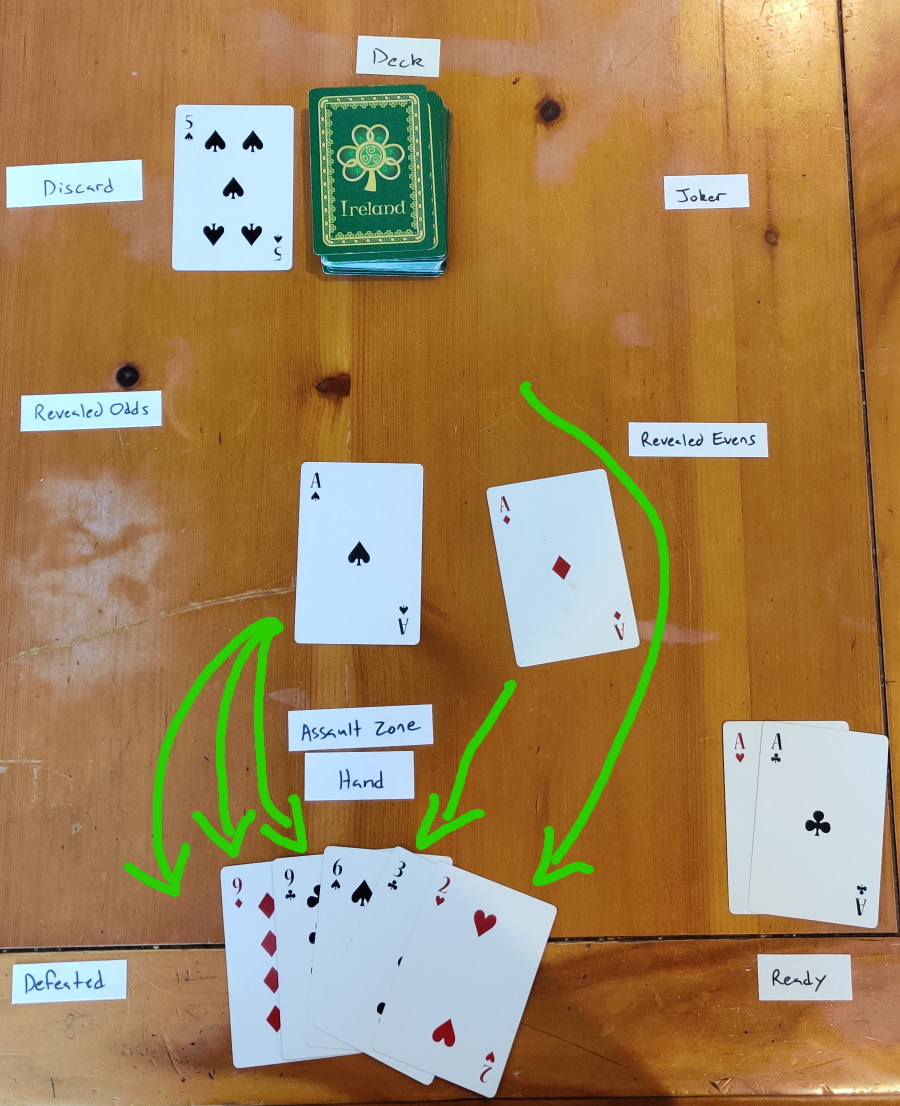
Cleanup Part 1: pickup all of the non-Ace cards used in the Assault
Equation.
Return all but the most recently deployed pilot to the Ready pile. Leave the most recently deployed pilot in The Assault Zone – you’ll be starting with them in the next Assault Equation.
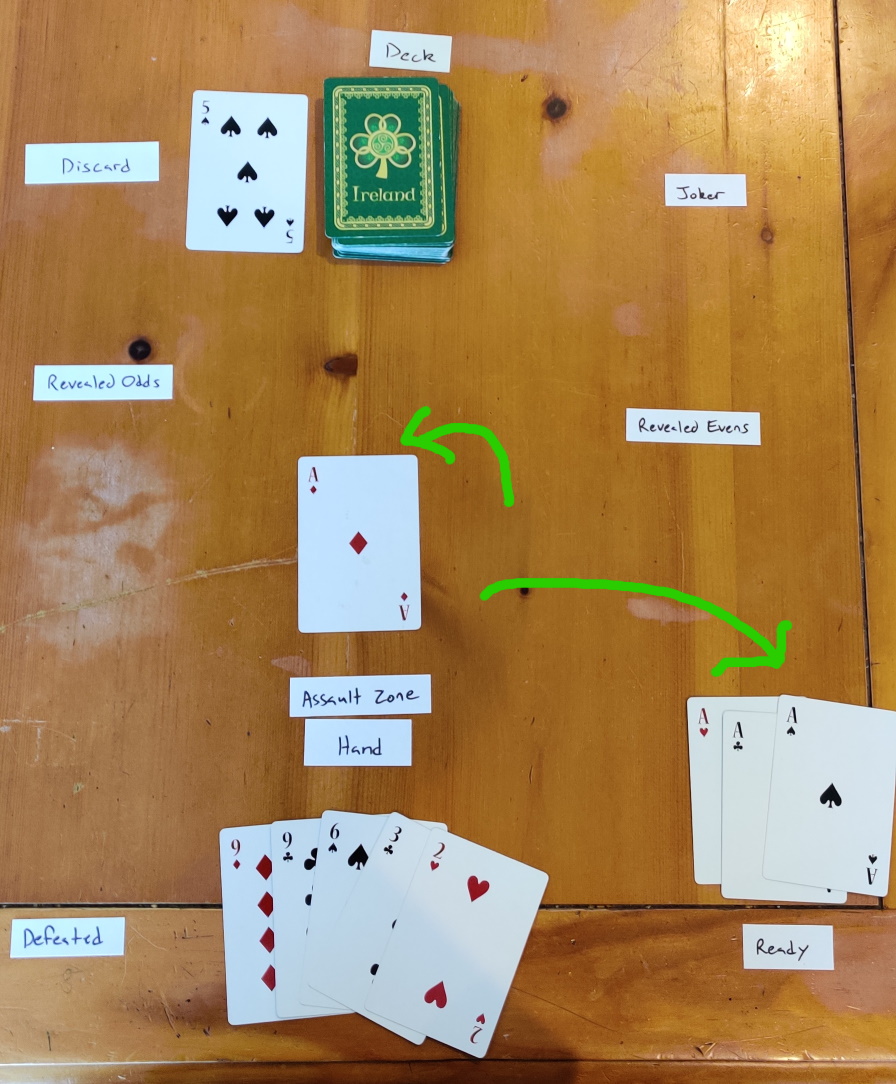
Cleanup Part 2 (Victory): The Ending Pilot (Duke) remains. The
others go to the Ready pile.
If you have a joker set aside and any Defeated pilots, you may Discard that joker and return all Defeated pilots to the Ready pile.
Send the Starting Pilot (not the one most recently played nor the one at the beginning of the equation, but the one you started the round with) to the Defeated pile face-down.
If you have a joker set aside, you must instead discard that joker and send your Starting Pilot to the Ready pile. That is not optional.
You don’t have to pick a new starting pilot until the end of the next Reveal step. This helps you get back on your feet.
Discard down to 3 cards in hand. Choose carefully which card is on top, as you may be forced to draw it next round if no odds are Revealed.
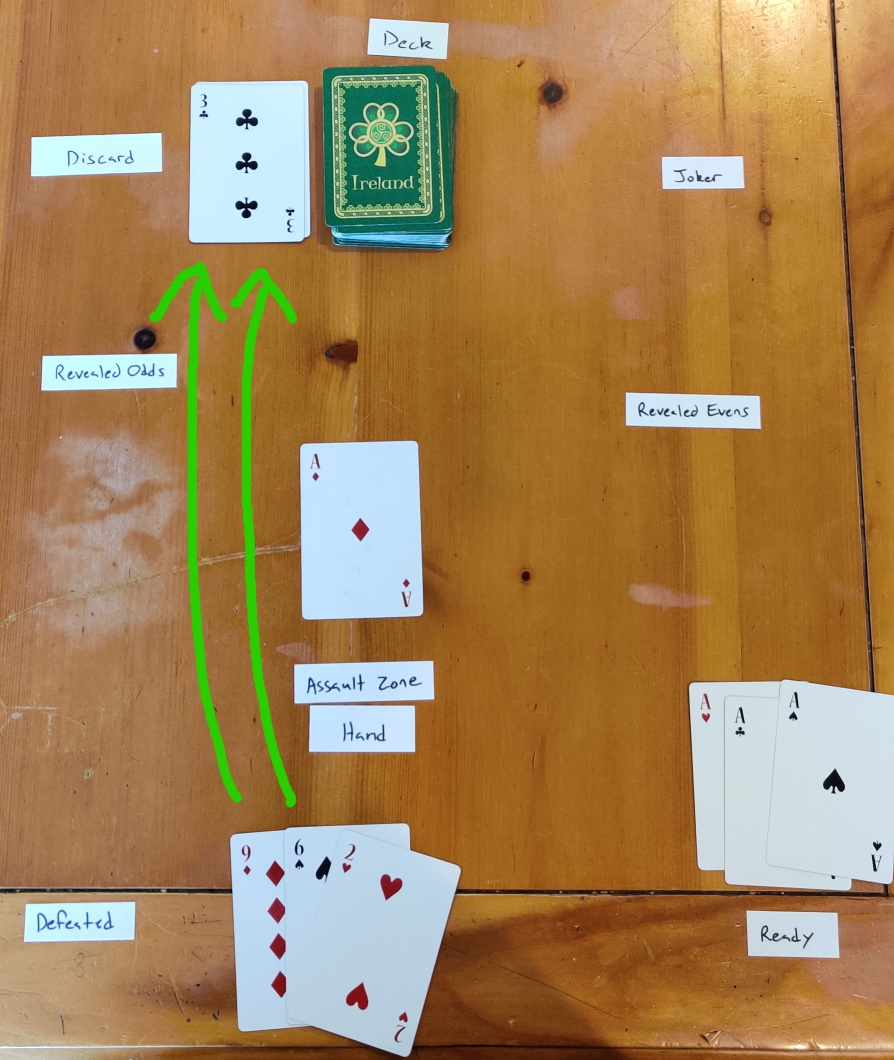
We chose
to discard the 9 and the 3, keeping the 3 on top.
Then return to the Reveal step for the next round, repeating until the deck is depleted (yay) or all of your Ace Pilots are Defeated (boo).
Let’s continue the playthrough established in our previous images so we can demonstrate some of the above concepts as they naturally occur.
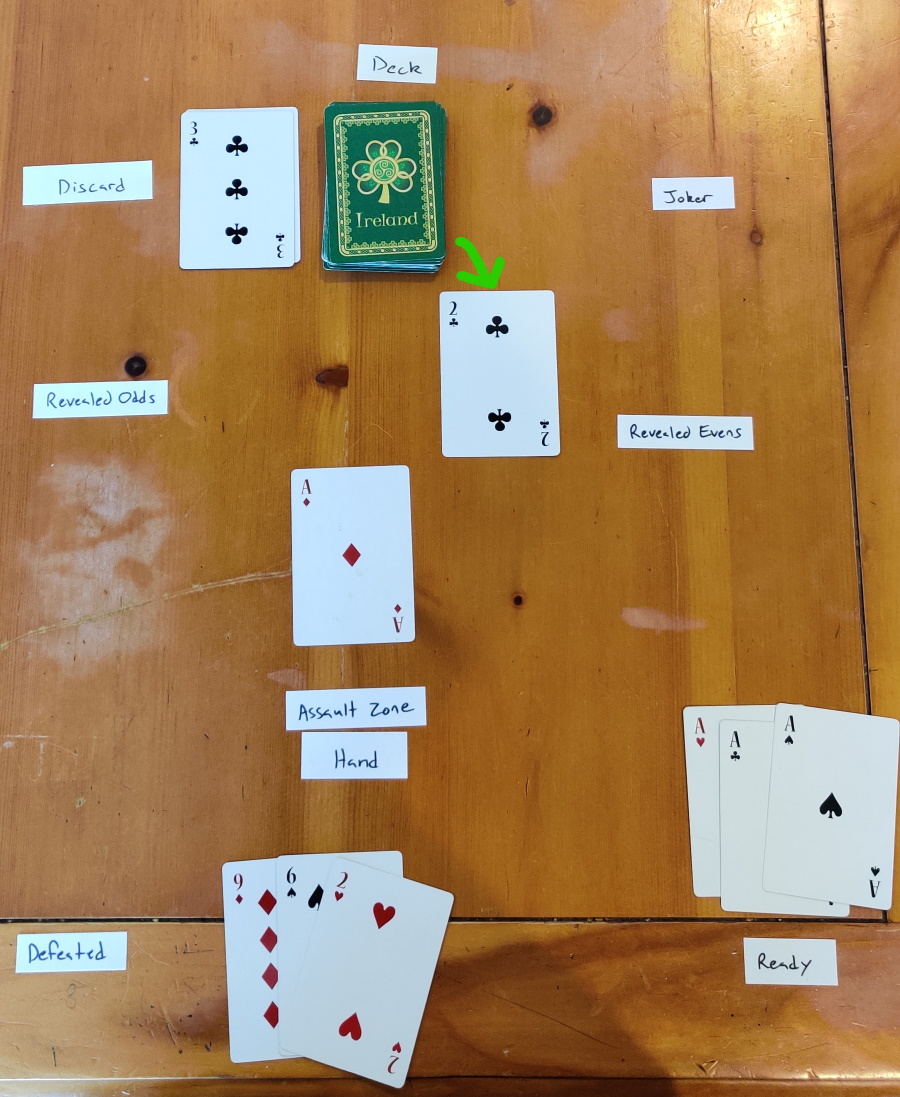
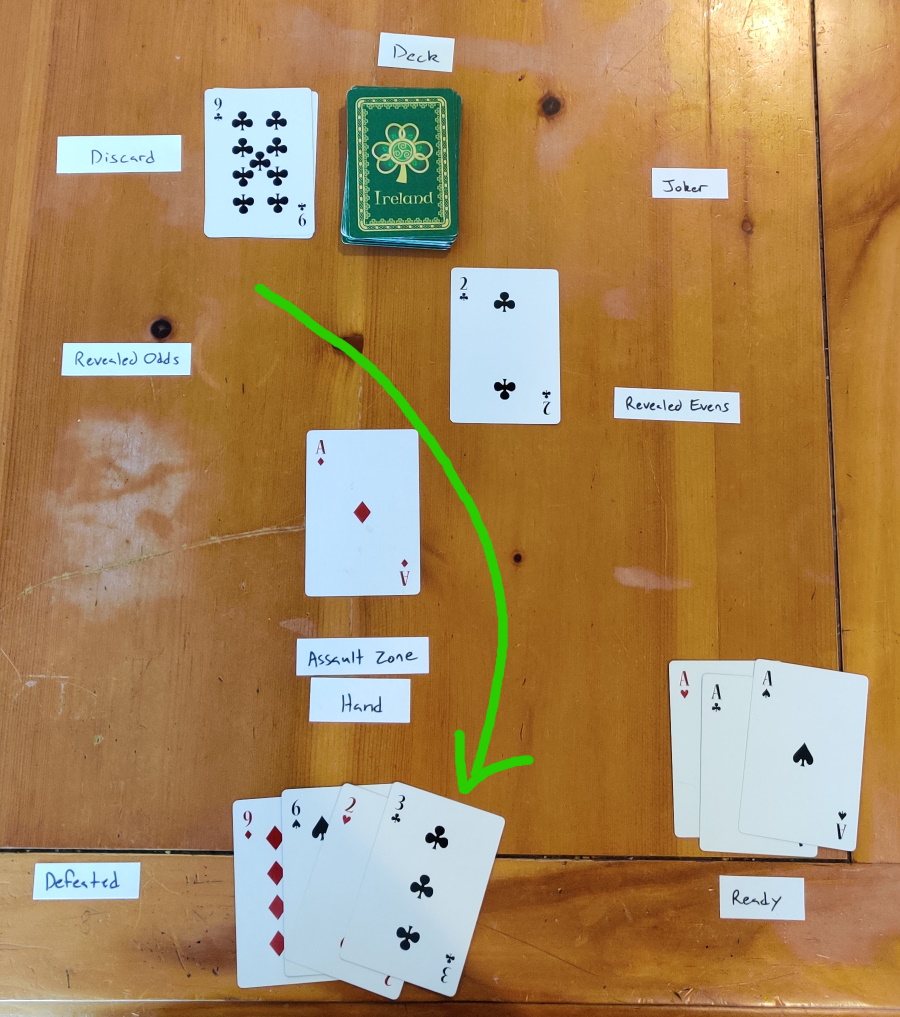
We revealed a
2. Therefore we must draw the 3.
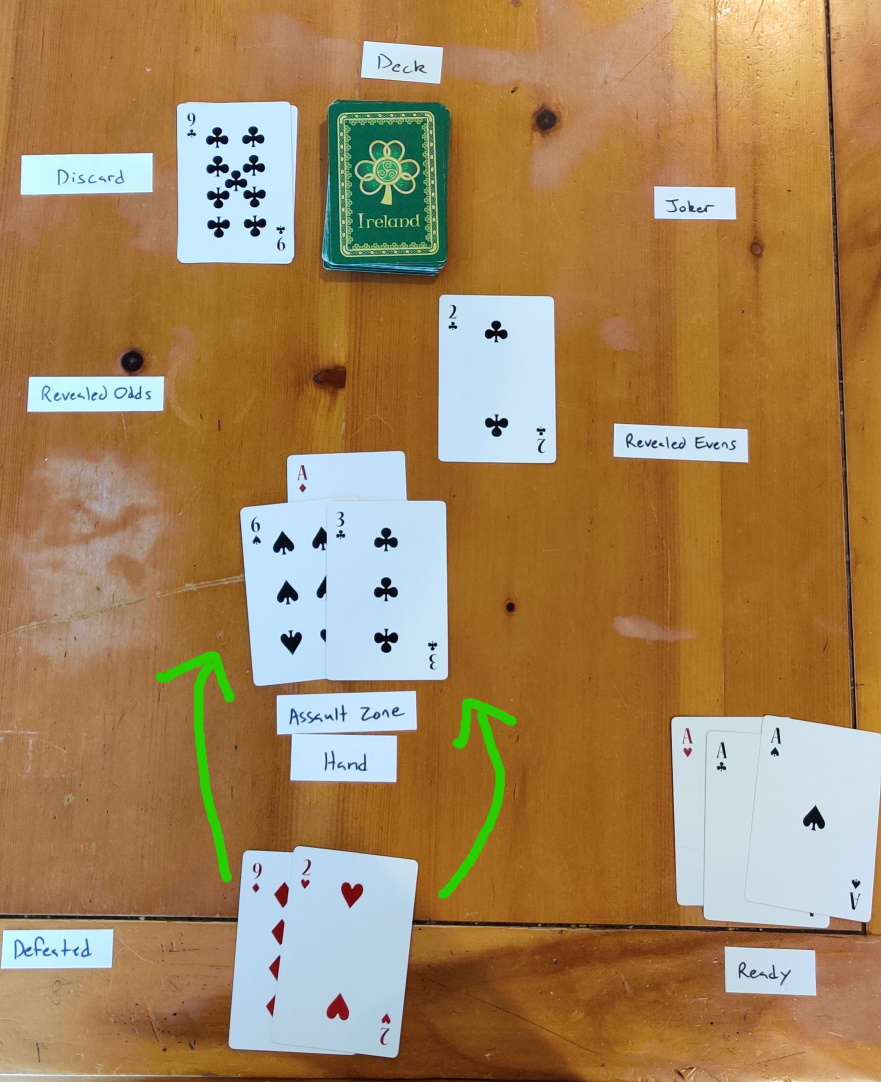
6 / 3 = 2!
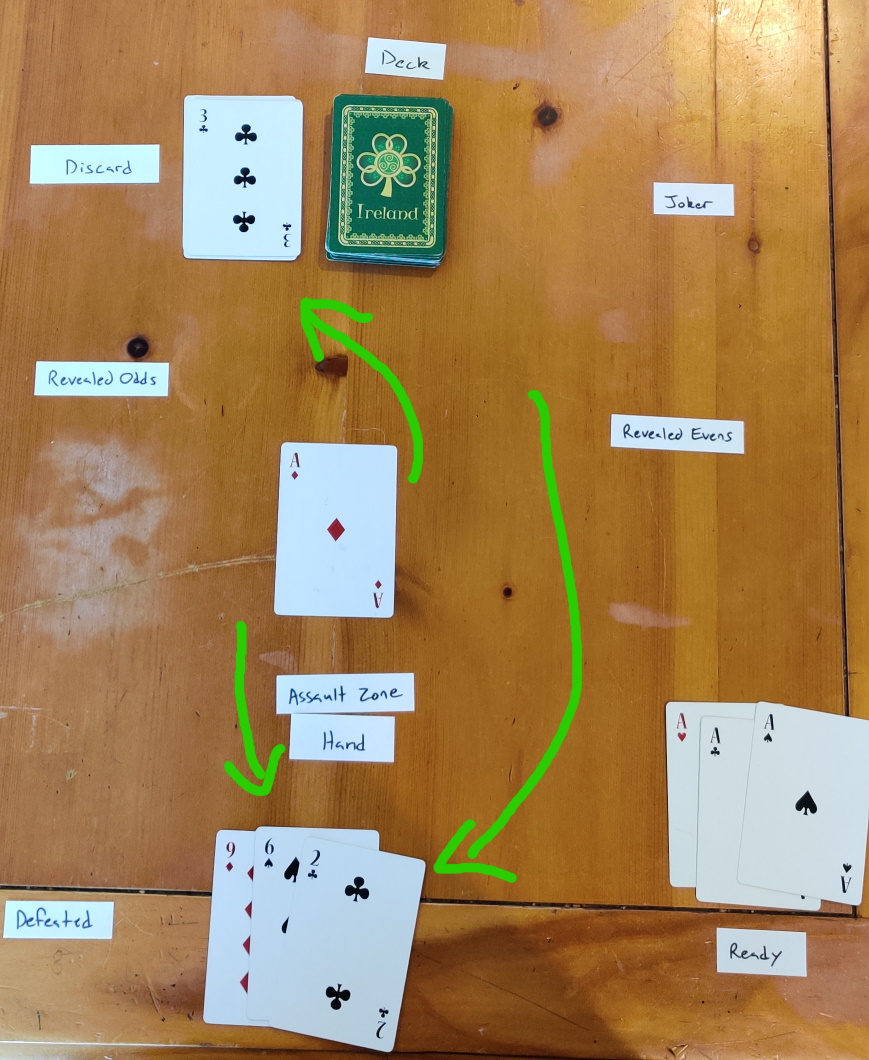
We kept the 9, 6, and 2 and discarded the rest.
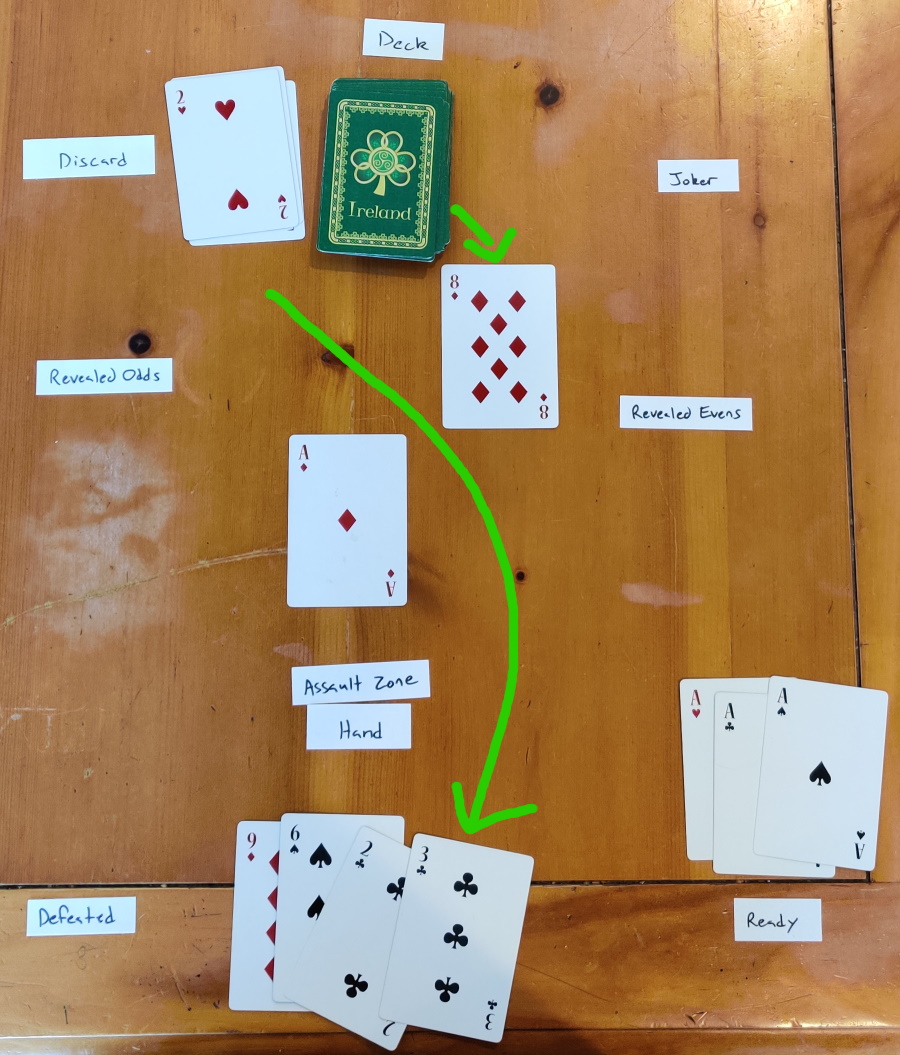
We
revealed an 8, so we must draw the 3.
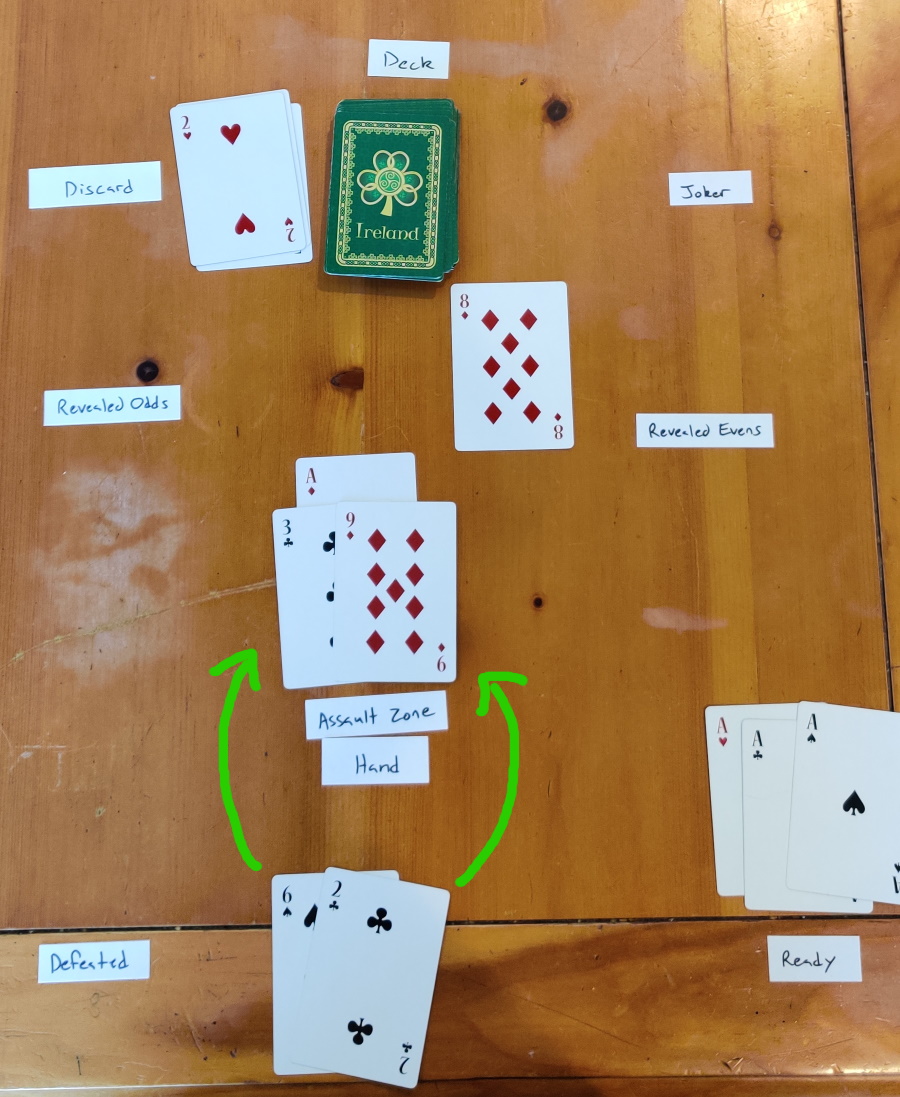
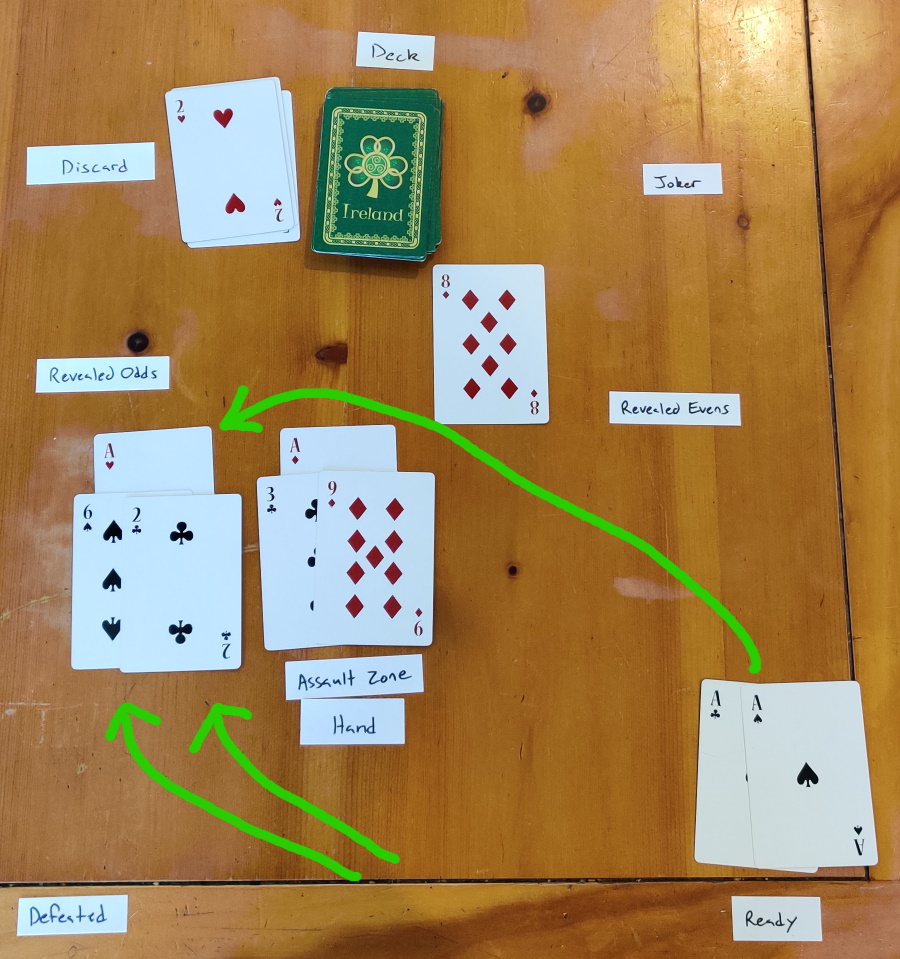
First we
play the 3 & 9 on Duke. Then we play Hailey to his left with the 6
& 2.
This is the rare case where two aces have two cards; we
resolve it as though the left ace has 3 cards with the 3rd value being
the resolution of the 2nd ace.
6 + 2 + (3 / 9 (round down)) = 8 + 0
= 8!

We
drew all the valued-cards, sent our non-Ending-Pilot back to Ready, and
Discarded 9 & 3 (3 on top).

We
revealed a 6 and so must draw the 3.

8 + 3 = 11.
(11) / 2 (round up) = 6.
Ignore the “Oops!” – we misread the card
values when image editing. Eye strain is a thing!
Because 2 is a
Carryover Card, and because it’s the last Ace in the equation it uses
the (8 + 3 = 11) as its input.

We
drew the valued-cards, kept our Ending Pilot, and discarded what we
didn’t want, leaving the 2 on top.

We
revealed a 12 (queen) and so must draw the 2.

8 / 6 (round
up) = 2. 3 x 2 = 6.
Oops! According to the rules, this should
evaluate as 8 / 6 / (3 x 2).
Pretend we put Cam on the left: 3 x 2 x
(8 / 6 = 2) = 6 x (2) = 12!

Our
Ending Pilot (Cam) stays, we pick up the other cards and Discard down to
3.

We revealed a 13
(king) before the 4. Therefore we must take the 13.

2 x 13
= 26. (26) / 6 (round down) = 4!
Hopefully you can tell what’s going
on without the arrows at this point.
They would’ve been a mess here.

Cleanup & Discard. You know the drill.

13 (king)
revealed before target 12 (queen). The 13 will go into our hand.

6 / 13 (round
up) = 1. 1 - 13 = -12 = 12. And some other thing in the corner.

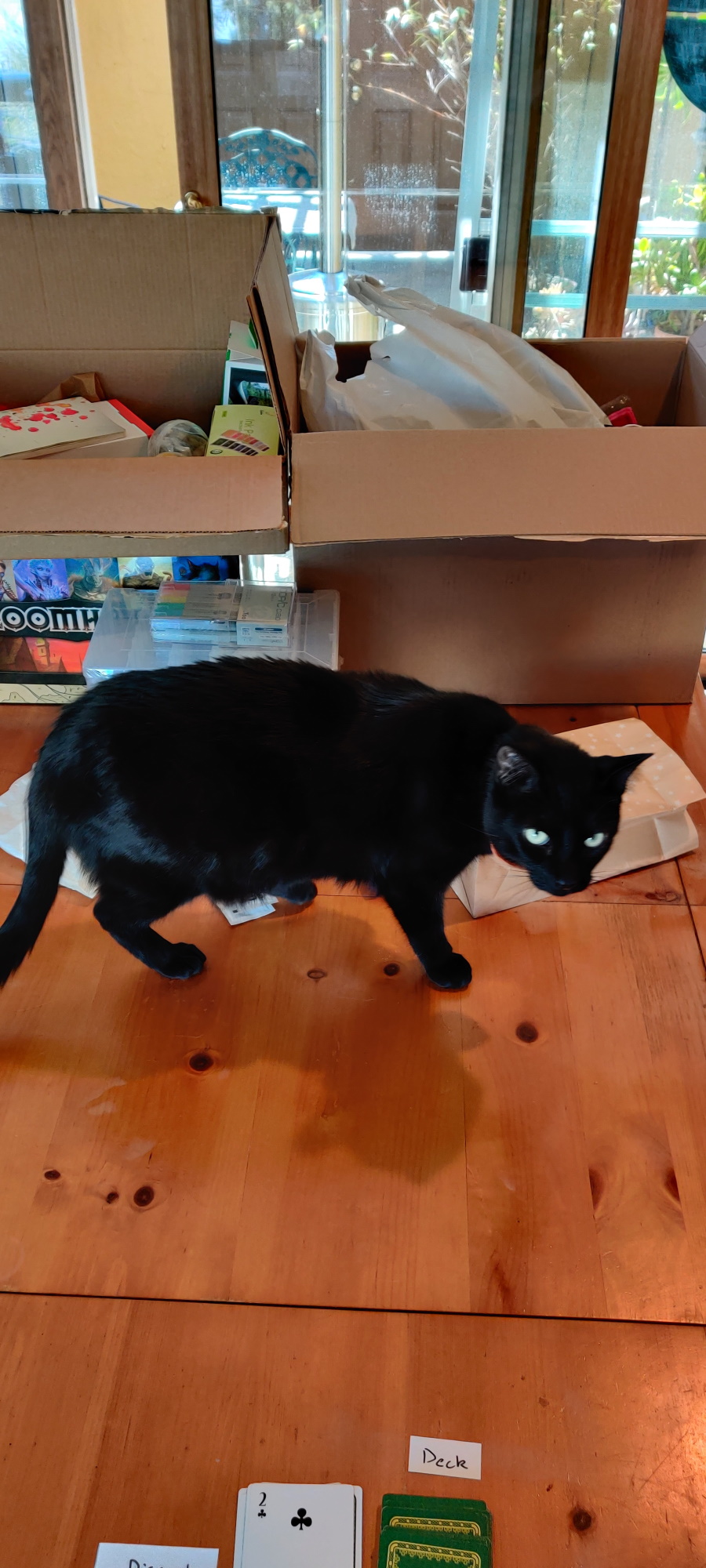
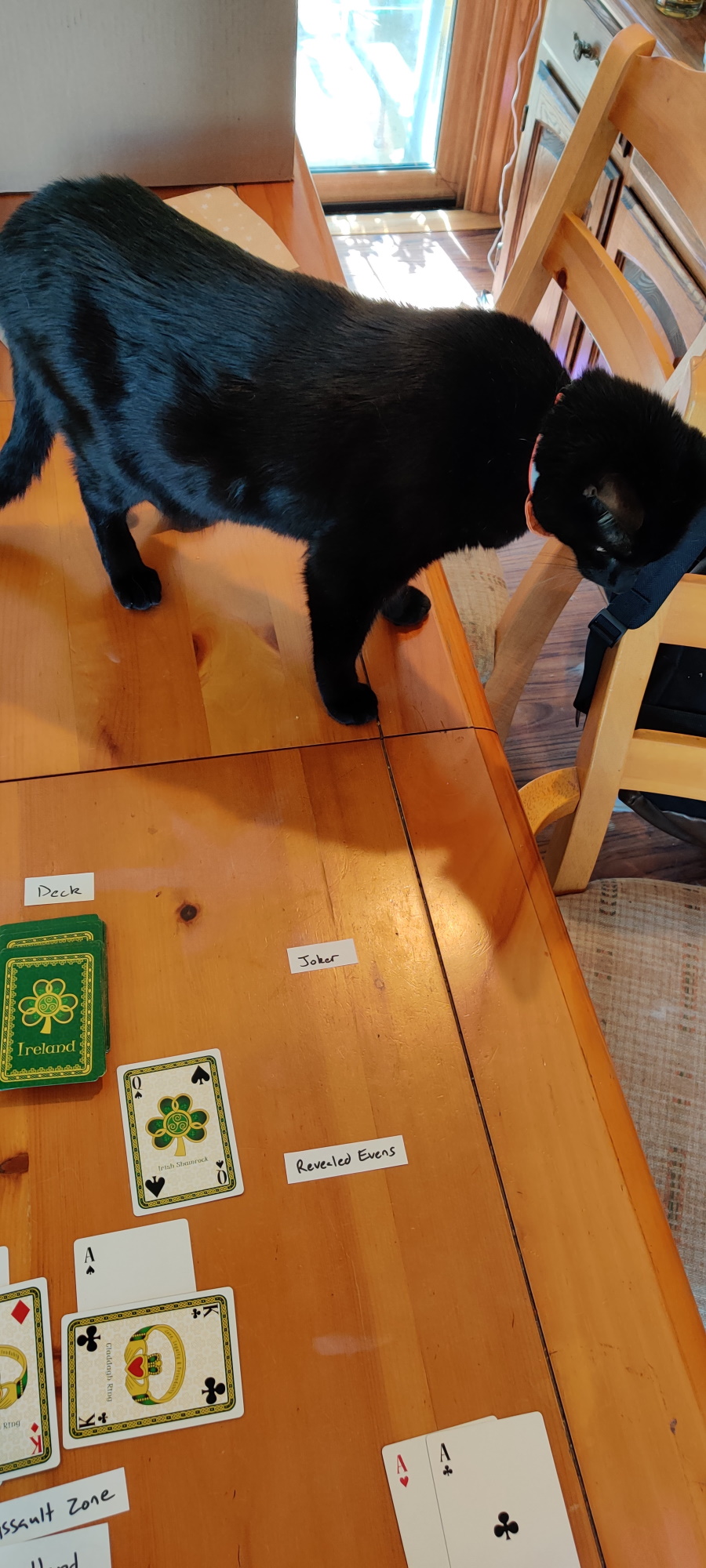
Is it
possible that that corner is more interesting than our game?
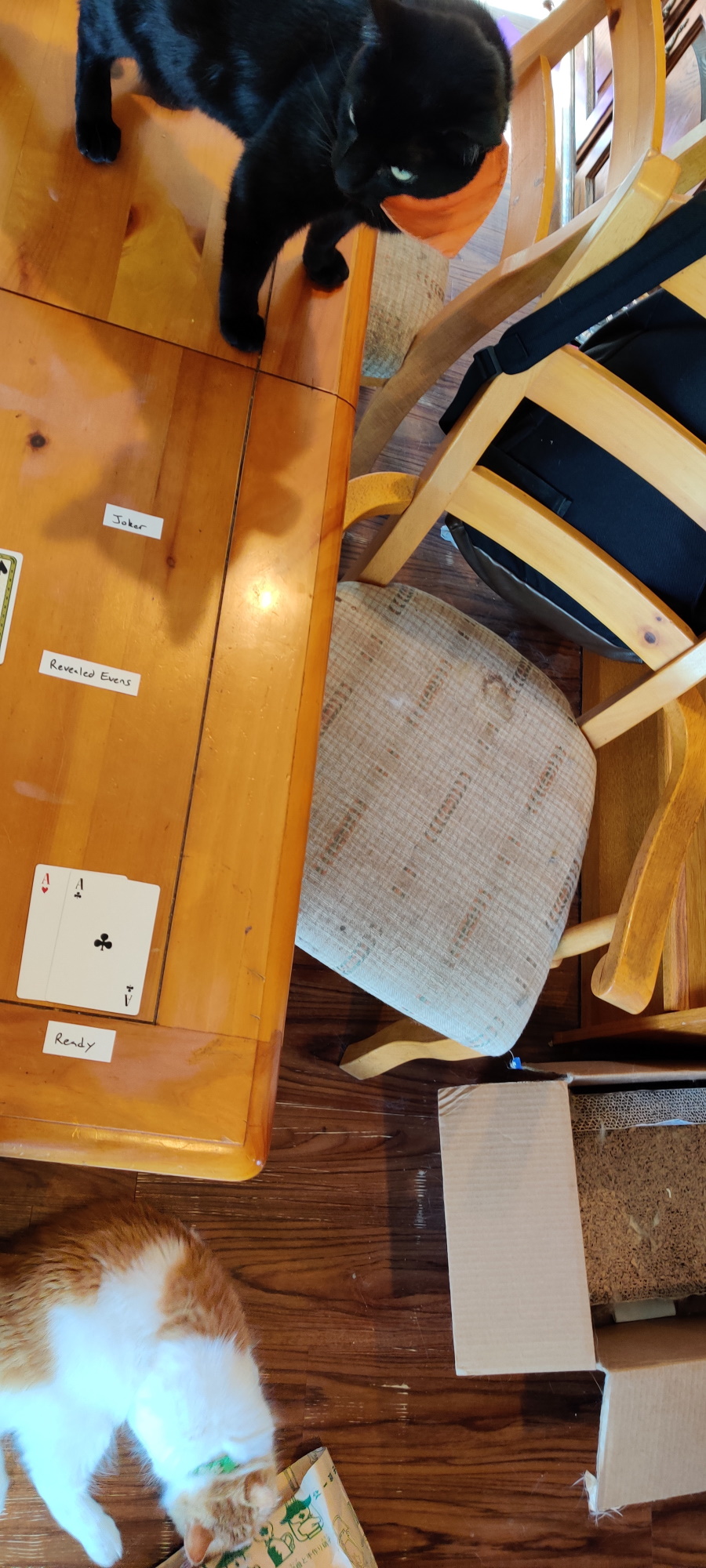
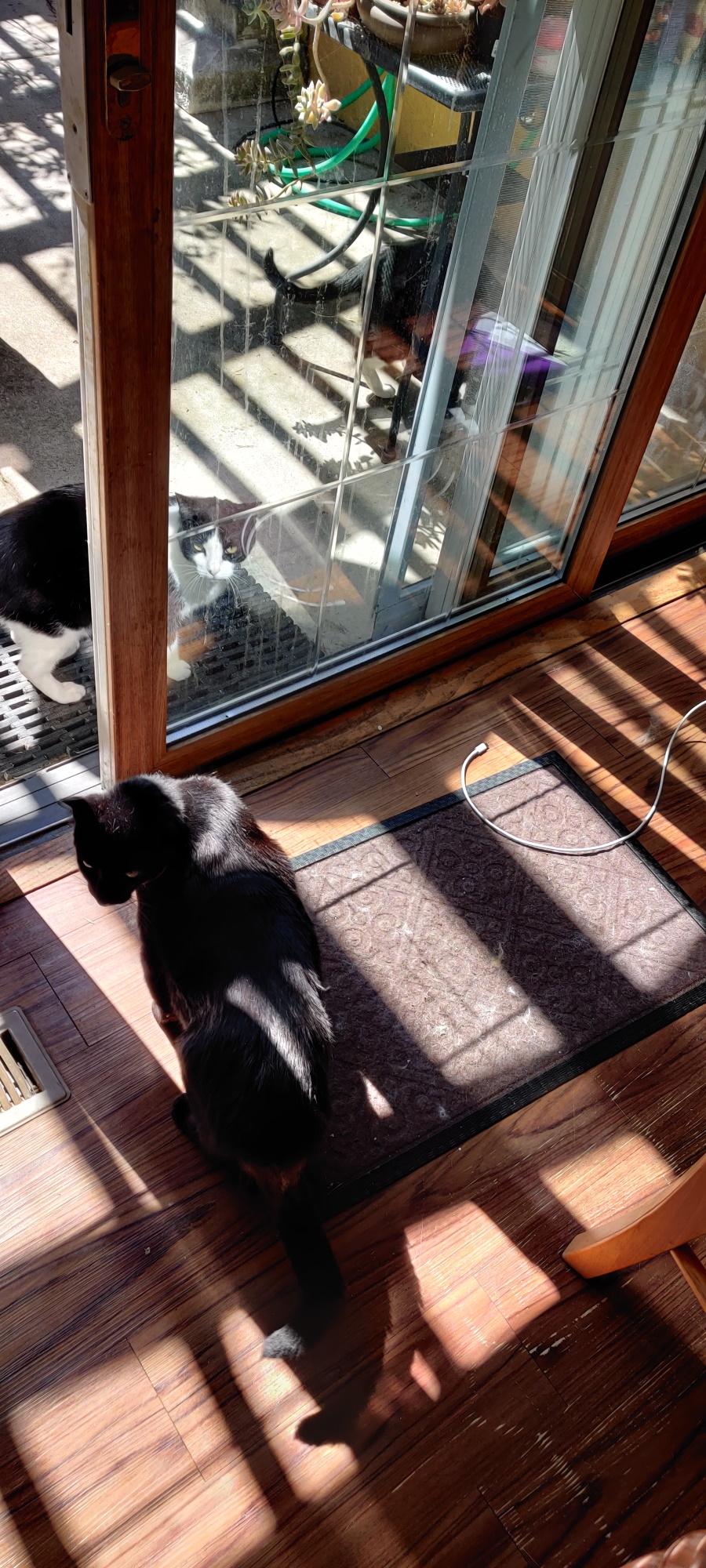
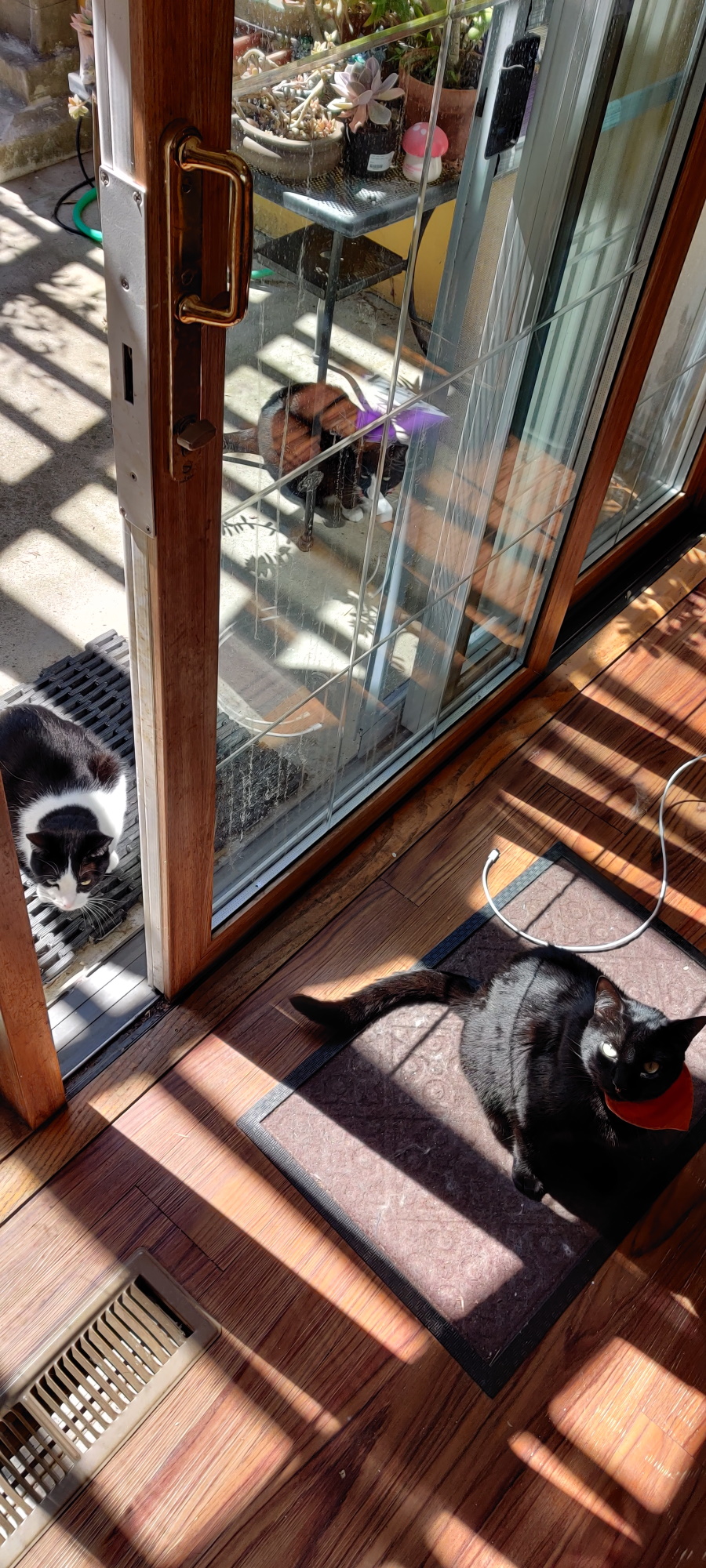
Can’t even
hold a cat’s attention for more than a minute.

Bwoop! Mission
accomplished.

12 (queen)
revealed, meaning 13 (king) goes into our hand.

This
one’s intricate. To resolve from left-to right, we start with Duke. 4 /
?
To figure out its second value, we resolve Sabina. 13 - 6 = 7. So
4 / 7 (round down) = 0.
And to resolve Hailey, 0 + 12 = 12!

We
happened to play Hailey last, though it equally well could’ve been Duke.


Finally a
joker is revealed! Set it in the Joker pile and keep revealing.
Took
a long while before we hit an even.
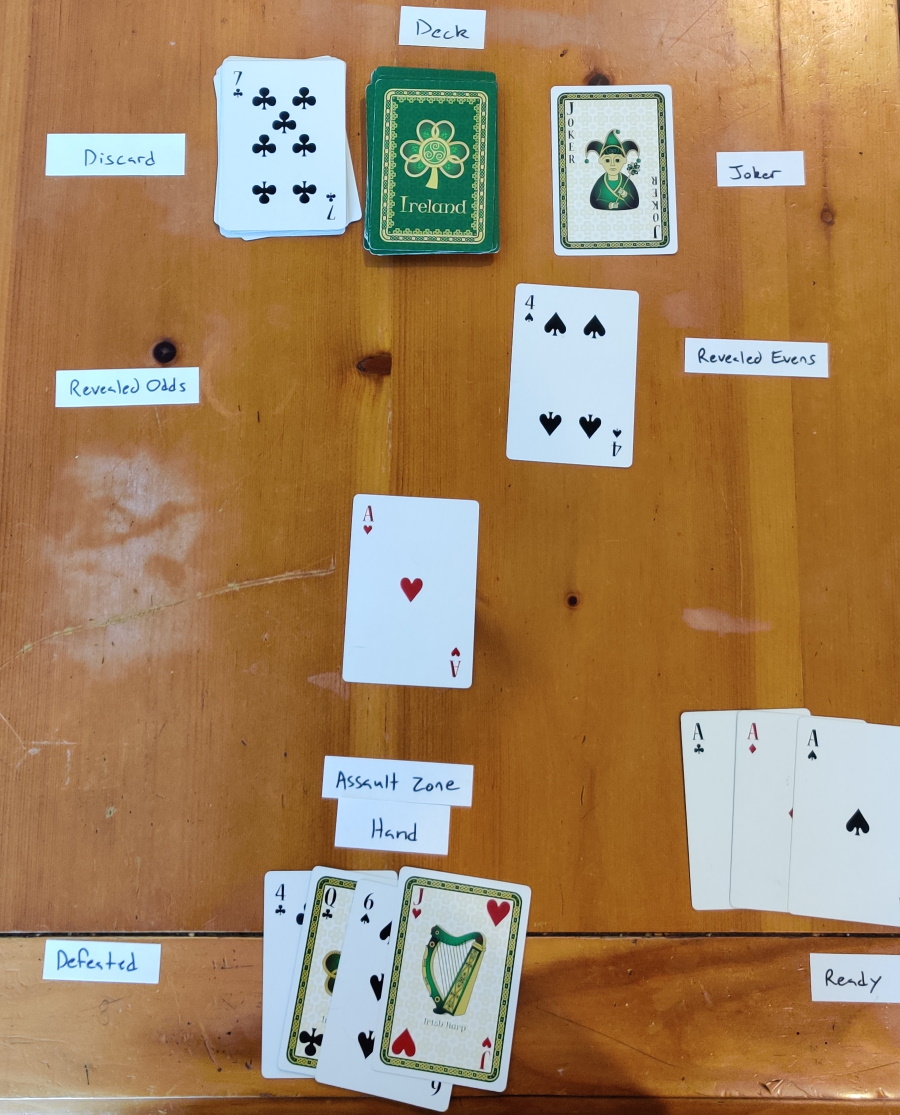
We decide that 11
(jack) would be the most useful to draw.
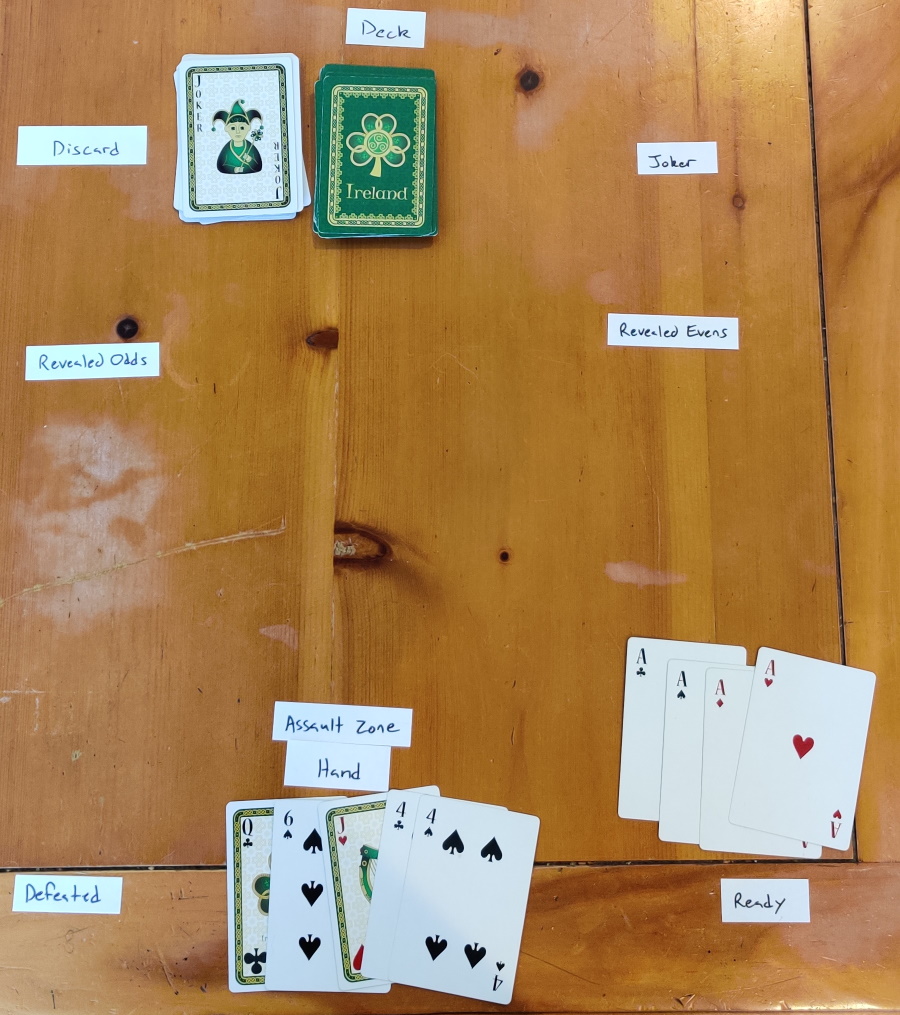
Let’s say we couldn’t solve that one and our equation ended in
Defeat.
Discard the joker (because we have one), then send all
(non-Defeated) Aces back to Ready.
As a consolation, we won’t have
to pick our Starting Pilot until next round.


We
Reveal an 8, which means we’ll draw the 11 (jack).
But first we must
choose a new Starting Pilot. We pick Duke.

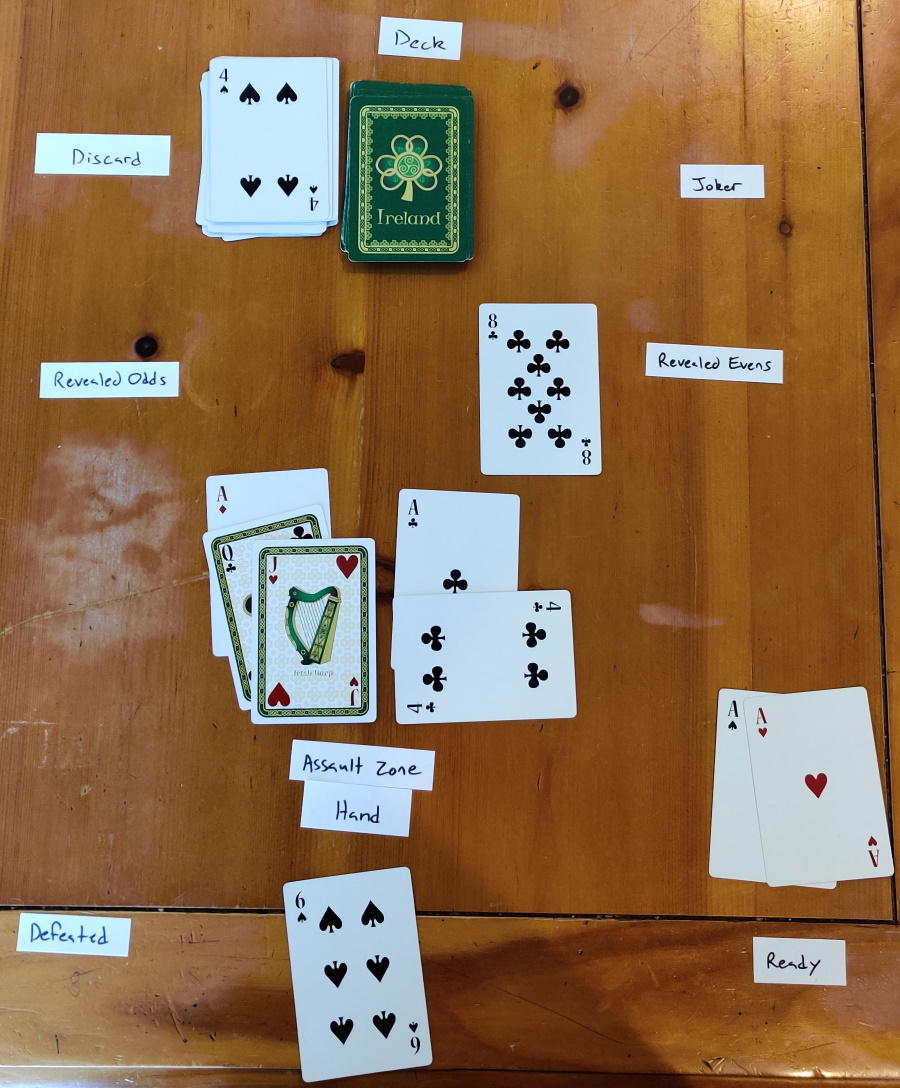
Only after
picking the pilot do we Draw.
12 / 11 (round up) = 2. 2 x 4 = 8!
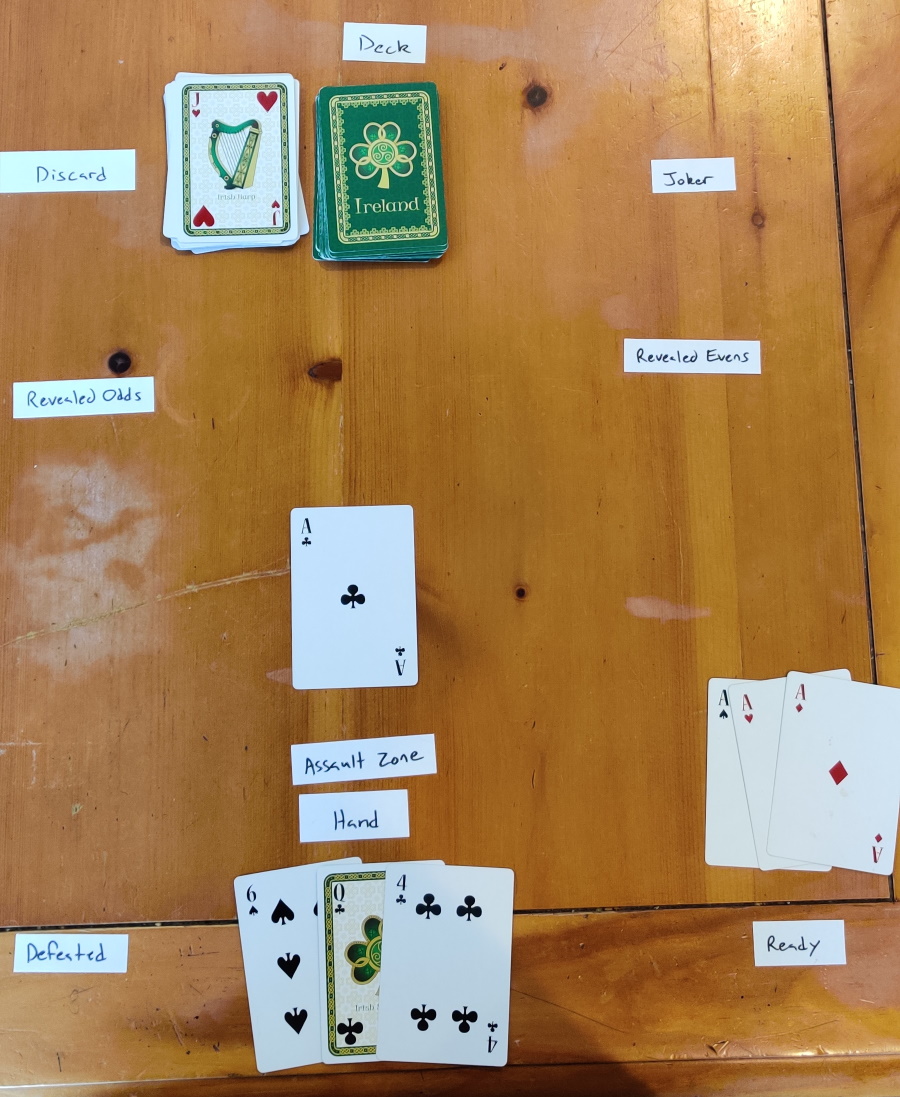
Cleanup & Discard.

We revealed a 10,
which means we’d draw the 8.

Let’s say this equation can’t be solved (though it can).
Because
we have no joker, our Starting Pilot is Defeated.
Then we cleanup as
usual.

As per the rules
of Defeat, we don’t have to pick our next pilot quite yet.
Hopefully at this point you get the picture. Certainly we ran out (of pictures).
What? But the game is hard enough already, you say? We say, “Nay nay!”
The game as described so far is considered Challenge Rating 1. Challenge rating 2 plays similarly, except that you Reveal cards until you hit 2 evens, and your goal is to solve the sum of them (8 + 10 = 18). Challenge Rating 3 is the same but with 3 evens, etc.
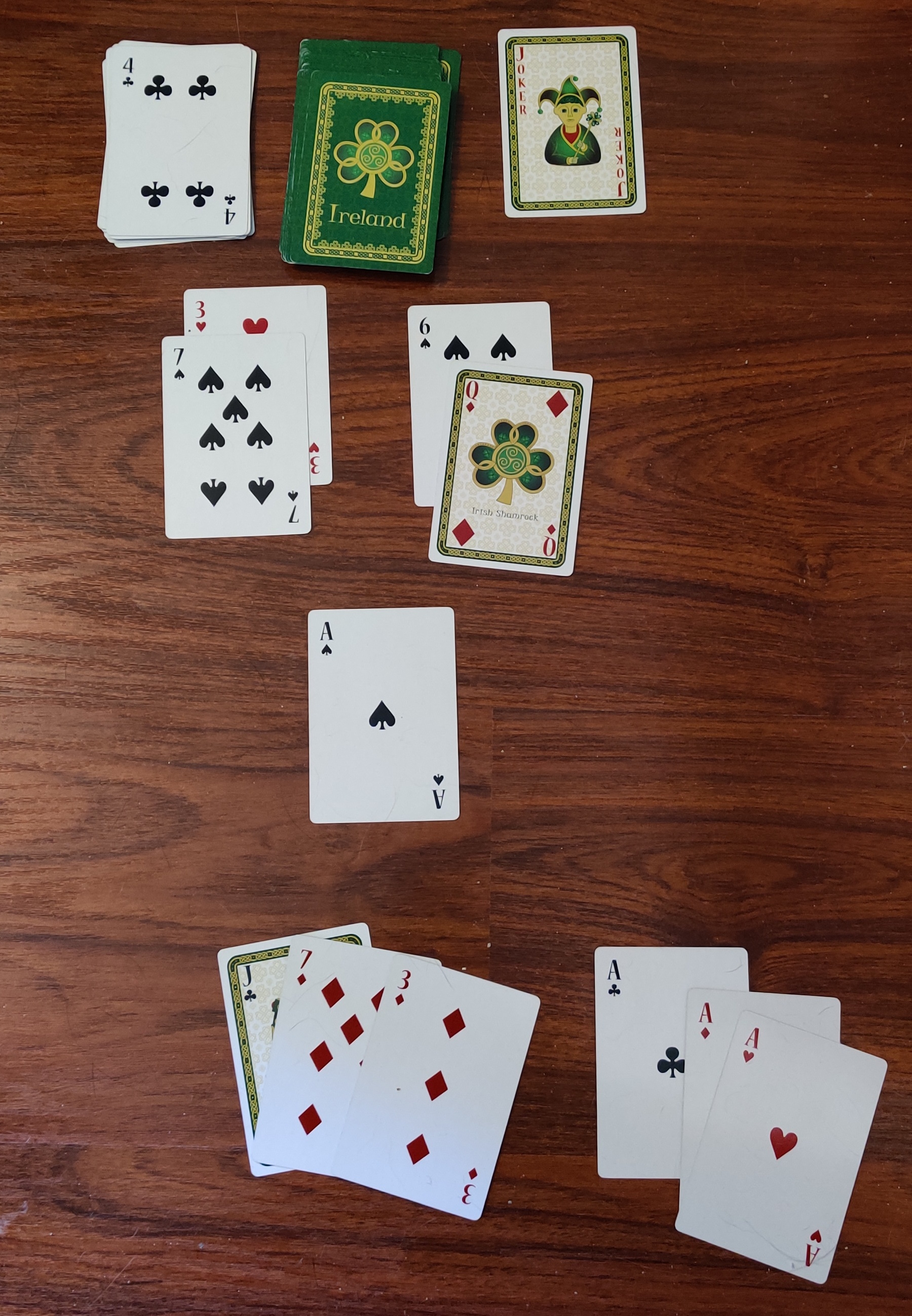
If you’re looking for an extended session, then after defeating the deck at your current Challenge Rating, keep any Defeated pilots Defeated and any unspent jokers set aside. That way it’s like you’re out on one long mission, with no breaks in-between.
Alternatively you could just choose to start at a higher Challenge Rating, but at some point you’ve clearly become too good at arithmetic and it’s time to move on. (Congratulations; you’re smart!)
In our testing we were able to defeat Challenge Ratings 1-5 consecutively, in the same sitting. While this doesn’t prove that every situation is winnable, it does strongly imply it. (We didn’t actually attempt Challenge Rating 6; our butt was sore!)
It’s often difficult starting with division; you can’t make numbers higher than they already are. But because division lets you choose to round up or down, you can often “round down” to 0 and then swap to Addition to get your desired total.
© 2023 Strange Hill to Die On Games LLC2